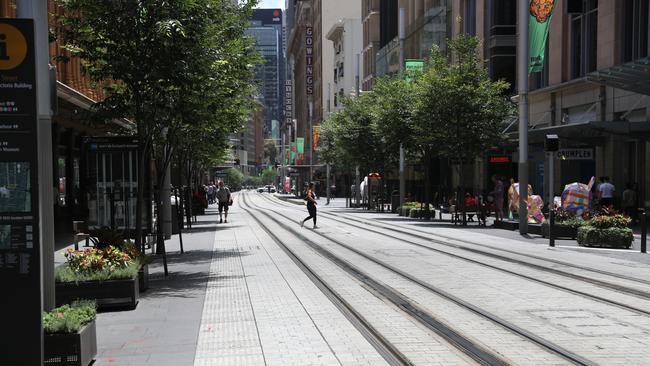Closed shops and increase in homeless spur calls for action on Sydney CBD
Sydney’s CBD has withered into a bleak wasteland, crushed by lockdowns, border bans and remote working. Here’s how we can fix it.
NSW Coronavirus News
Don't miss out on the headlines from NSW Coronavirus News. Followed categories will be added to My News.
Desolate streets. Boarded-up shop fronts. A sudden surge in homeless people camped in derelict doorways.
Two years of pandemic lockdowns, a shutdown of Australia’s international borders, and a hesitancy among workers to return to the office in the middle of the country’s worst Covid-19 outbreak has created the “perfect storm” that is ruining the Sydney CBD, and prompting politicians and business leaders to call for urgent action to turbocharge the economy.

The Daily Telegraph can reveal a staggering 71 per cent of people shunned the business area in the first year of the coronavirus pandemic, with an average 9200 pedestrians counted on a weekday in 2020 — compared with 31,000 the previous year.
City of Sydney last year recorded an average 8900 city pedestrians a day, with most people choosing to continue working from home.
As the empty city becomes a magnet to cohorts of homeless people setting up camp outside Pitt Street Mall and along George, Erskine, Clarence and Liverpool streets, analysts foreshadow a trend towards San Francisco — a US city currently home to more than 8000 homeless.
Sydney’s homeless come in search of undisturbed shelter, company among other rough sleepers and the chance to beg for cash from returning workers.


“It’s become a serious problem in the last three months, growing numbers are camping on CBD doorstops and restaurant entrances and discouraging patrons,” high-profile ex-Liberal councillor Christine Forster said.
“We need urgent action from the Lord Mayor to co-ordinate her rangers and work with support groups and the police to get the homeless off the streets. Sydney cannot become another San Francisco.”
NSW Police are powerless to move on the homeless but can issue fines when they ignore a move-on direction should they commit offences or block accesses.
“We can’t ignore it’s an issue in Sydney now — no one wants to be unkind and move on the homeless, but it’s bad for struggling businesses,” celebrity chef Luke Mangan, whose restaurant, glass brasserie, is in the CBD’s Hilton hotel, said.
“We need to create energy to lure people back into offices. City workers go to shops and bars and go retail shopping — without them the ‘for lease’ signs will keep going up.”
About 15 per cent of retail space in the CBD was empty in October, a record rate three times higher than it was during the global financial crisis, according to the Reserve Bank of Australia.
The Property Council of Australia’s Office Market Report released on Friday found tenant demand lifted an average 1 per cent in the CBD with unleased office space remaining steady at 9.3 per cent — in early 2020 it was just 3.9 per cent.
Heavyweight firms Westpac and HSBC confirmed last year they were reducing staff numbers at Lendlease’s $4.6 billion premium offices on the Barangaroo foreshore, signalling less need for a large footprint in the CBD.
The Committee for Sydney, a think tank backed by government and business, says live music, 24-hour markets, multiple use of empty shopfronts, and free public transport zones would help the CBD regain its vibrancy.
“Sydney is still a 9am-5pm city, it needs to become 24 hours to survive,” deputy CEO Ehssan Veiszadeh said.
The City’s independent Councillor Yvonne Weldon said planning must include affordable housing to reverse growing homelessness.


During the height of the pandemic, rough sleepers were provided indefinite temporary accommodation in hotels, motels and caravan sites which the Department of Communities and Justice ended with the last lockdown in October.
While City of Sydney recorded a dip in homeless rates, frontline workers have noted a “visible” rise in street sleepers since last lockdown.
New Google data reveals the number of people in workplaces across the City of Sydney dropped 23 per cent from its pre-pandemic baseline as of January 23.
The data showed retail, hospitality and recreation visits were down 42 per cent, while public transport dipped 51 per cent.
A return of international tourism, removing restrictions on late-night opening hours and a comeback to the office were fundamental to refiring the CBD, chairman of Venues NSW Tony Shepherd said.
“Capital cities are wealth generators, how can a state and country expand with a dead centre?” he said.
More Coverage
Originally published as Closed shops and increase in homeless spur calls for action on Sydney CBD




